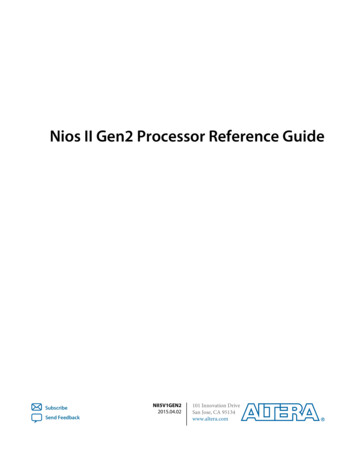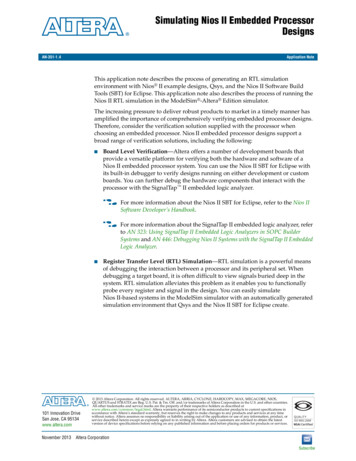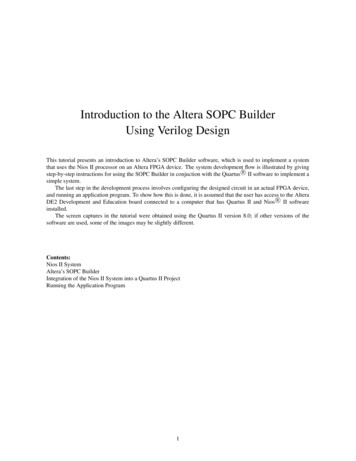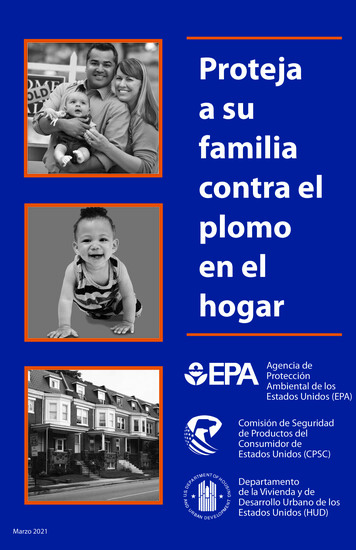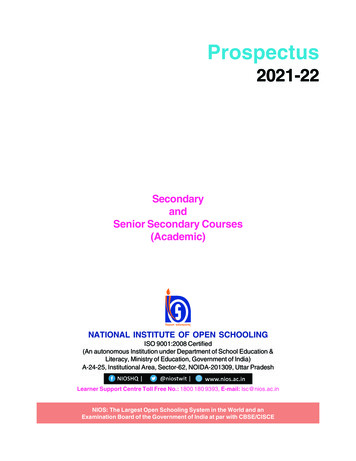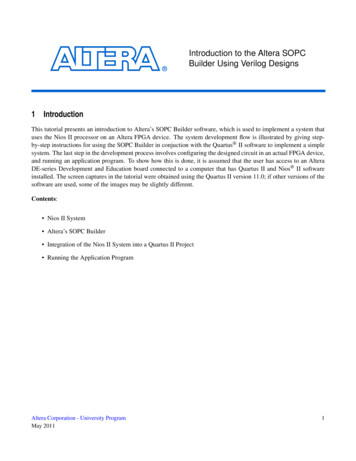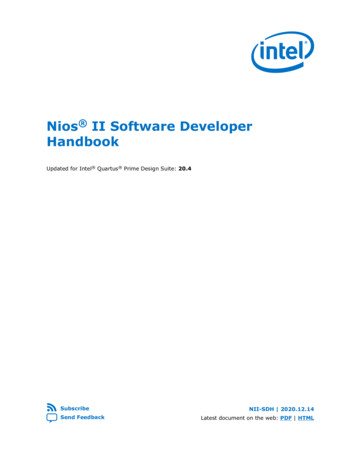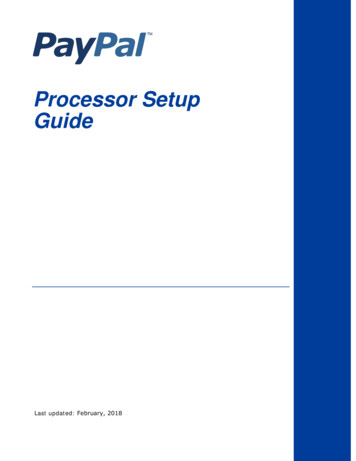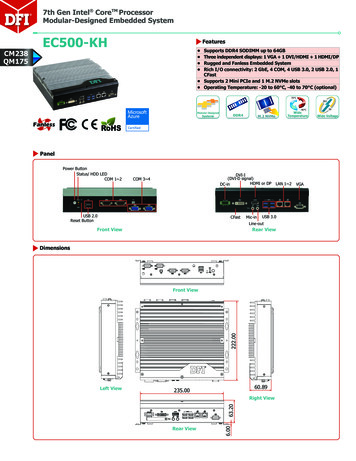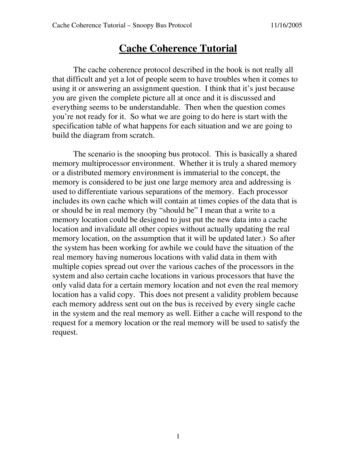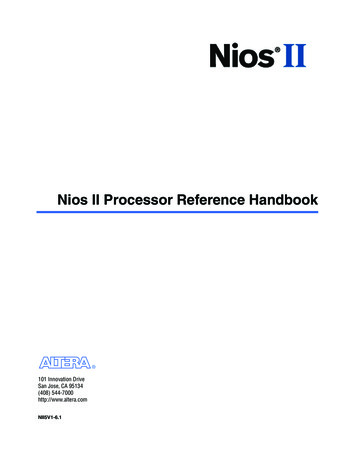
Transcription
Nios II Processor Reference Handbook101 Innovation DriveSan Jose, CA 95134(408) 544-7000http://www.altera.comNII5V1-6.1
Copyright 2006 Altera Corporation. All rights reserved. Altera, The Programmable Solutions Company, the stylized Altera logo, specific device designations, and all other words and logos that are identified as trademarks and/or service marks are, unless noted otherwise, the trademarks andservice marks of Altera Corporation in the U.S. and other countries. All other product or service names are the property of their respective holders. Altera products are protected under numerous U.S. and foreign patents and pending applications, maskwork rights, and copyrights. Altera warrantsperformance of its semiconductor products to current specifications in accordance with Altera's standard warranty, but reserves the right to makechanges to any products and services at any time without notice. Altera assumes no responsibility or liability arising out of the application or use of any information, product, or service described herein except as expressly agreed to in writing by AlteraCorporation. Altera customers are advised to obtain the latest version of device specifications before relying on any published information and before placing orders for products or services.Printed on recycled paperiiAltera Corporation
ContentsChapter Revision Dates . ixAbout This Handbook . xiIntroduction . xiAssumptions about the Reader . 1–xiHow to Find Further Information . xiiHow to Contact Altera . xiiTypographical Conventions . xiiiSection I. Nios II ProcessorChapter 1. IntroductionIntroduction .Nios II Processor System Basics .Getting Started with the Nios II Processor .Customizing Nios II Processor Designs .Configurable Soft-Core Processor Concepts .Configurable Soft-Core Processor .Flexible Peripheral Set & Address Map .Custom Instructions .Automated System Generation .Document Revision History 6Chapter 2. Processor ArchitectureIntroduction .Processor Implementation .Register File .Arithmetic Logic Unit .Unimplemented Instructions .Custom Instructions .Floating Point Instructions .Reset Signals .Exception & Interrupt Controller .Exception Controller .Integral Interrupt Controller .Interrupt Vector Custom Instruction .Memory & I/O Organization .Instruction & Data Buses .Altera 52–62–62–62–62–82–9iii
ContentsCache Memory .Tightly Coupled Memory .Address Map .JTAG Debug Module .JTAG Target Connection .Download & Execute Software .Software Breakpoints .Hardware Breakpoints .Hardware Triggers .Trace Capture .Document Revision History –162–172–19Chapter 3. Programming ModelIntroduction . 3–1General-Purpose Registers . 3–1Control Registers . 3–2Operating Modes . 3–4Normal Mode . 3–5Debug Mode . 3–5Changing Modes . 3–5Exception Processing . 3–5Exception Types . 3–6Determining the Cause of Exceptions . 3–9Nested Exceptions . 3–10Returning from an Exception . 3–10Break Processing . 3–11Processing a Break . 3–11Returning from a Break . 3–11Register Usage . 3–11Memory & Peripheral Access . 3–12Addressing Modes . 3–12Cache Memory . 3–12Processor Reset State . 3–13Instruction Set Categories . 3–14Data Transfer Instructions . 3–14Arithmetic & Logical Instructions . 3–16Move Instructions . 3–17Comparison Instructions . 3–17Shift & Rotate Instructions . 3–18Program Control Instructions . 3–19Other Control Instructions . 3–20Custom Instructions . 3–20No-Operation Instruction . 3–20Potential Unimplemented Instructions . 3–21Document Revision History . 3–21ivNios II Processor Reference HandbookAltera Corporation
ContentsChapter 4. Implementing the Nios II Processor in SOPC BuilderIntroduction . 4–1Nios II Core Tab . 4–2Core Setting . 4–2Multiply & Divide Settings . 4–3Caches & Tightly Coupled Memories Tab . 4–4Instruction Settings . 4–4Data Settings . 4–5Advanced Features Tab . 4–5JTAG Debug Module Tab . 4–6Debug Level Settings . 4–8On-Chip Trace Buffer Settings . 4–9Custom Instructions Tab . 4–10Floating-Point Custom Instructions . 4–10Interrupt Vector Custom Instruction . 4–12System-Dependent Nios II Processor Settings . 4–12Reset Address . 4–13Exception Address . 4–14Break Location . 4–14Document Revision History . 4–15Section II. AppendixesChapter 5. Nios II Core Implementation DetailsIntroduction . 5–1Device Family Support . 5–2Nios II/f Core . 5–3Overview . 5–3Register File . 5–4Arithmetic Logic Unit . 5–4Memory Access . 5–6Tightly Coupled Memory . 5–8Execution Pipeline . 5–8Instruction Performance . 5–10Exception Handling . 5–11JTAG Debug Module . 5–12Unsupported Features . 5–12Nios II/s Core . 5–12Overview . 5–12Register File . 5–13Arithmetic Logic Unit . 5–13Memory Access . 5–14Tightly Coupled Memory . 5–15Execution Pipeline . 5–16Instruction Performance . 5–17Altera CorporationvNios II Processor Reference Handbook
ContentsException Handling .JTAG Debug Module .Unsupported Features .Nios II/e Core .Overview .Register File .Arithmetic Logic Unit .Memory Access .Instruction Execution Stages .Instruction Performance .Exception Handling .JTAG Debug Module .Unsupported Features .Document Revision History –205–205–215–215–215–21Chapter 6. Nios II Processor Revision HistoryIntroduction .Nios II Versions .Architecture Revisions .Core Revisions .Nios II/f Core .Nios II/s Core .Nios II/e Core .JTAG Debug Module Revisions .Document Revision History ter 7. Application Binary InterfaceData Types . 7–1Memory Alignment . 7–1Register Usage . 7–2Stacks . 7–3Frame Pointer Elimination . 7–4Call Saved Registers . 7–4Further Examples of Stacks . 7–5Function Prologs . 7–6Arguments & Return Values . 7–8Arguments . 7–8Return Values . 7–8Document Revision History . 7–10Chapter 8. Instruction Set ReferenceIntroduction .Word Formats .I-Type .R-Type .J-Type .Instruction Opcodes .viNios II Processor Reference Handbook8–18–18–18–28–38–4Altera Corporation
ContentsAssembler Pseudo-instructions . 8–6Assembler Macros . 8–7Instruction Set Reference . 8–8Document Revision History . 8–103Altera CorporationviiNios II Processor Reference Handbook
ContentsviiiNios II Processor Reference HandbookAltera Corporation
Chapter Revision DatesThe chapters in this book, Nios II Processor Reference Handbook, were revised on the following dates.Where chapters or groups of chapters are available separately, part numbers are listed.Chapter 1. IntroductionRevised:Part number:November 2006NII51001-6.1.0Chapter 2. Processor ArchitectureRevised:November 2006Part number: NII51002-6.1.0Chapter 3. Programming ModelRevised:November 2006Part number: NII51003-6.1.0Chapter 4. Implementing the Nios II Processor in SOPC BuilderRevised:November 2006Part number: NII51004-6.1.0Chapter 5. Nios II Core Implementation DetailsRevised:November 2006Part number: NII51015-6.1.0Chapter 6. Nios II Processor Revision HistoryRevised:November 2006Part number: NII51018-6.1.0Chapter 7. Application Binary InterfaceRevised:November 2006Part number: NII51016-6.1.0Chapter 8. Instruction Set ReferenceRevised:November 2006Part number: NII51017-6.1.0Altera Corporationix
Chapter Revision DatesxNios II Processor Reference HandbookAltera Corporation
About This HandbookIntroductionThe handbook you are holding (the Nios II Processor Reference Handbook) isthe primary reference for the Nios II family of embedded processors.This handbook answers the question “What is the Nios II processor?”from a high-level conceptual description to the low-level details ofimplementation. The chapters in this handbook define the Nios IIprocessor architecture, the programming model, the instruction set, andmore.This handbook is part of a larger collection of documents covering theNios II processor and its usage. See “How to Find Further Information”.Assumptions about the ReaderThis handbook assumes you have a basic familiarity with embeddedprocessor concepts. You do not need to be familiar with any specificAltera technology or with Altera development tools. This handbook waswritten intentionally to minimize discussion of hardwareimplementation details of the processor system. That said, the Nios IIprocessor was designed for Altera field programmable gate array (FPGA)devices, and FPGA implementation concepts will inevitably arise fromtime to time. While familiarity with FPGA technology is not required, itmay give you a deeper understanding of the engineering tradeoffs thatwent into the design and implementation of the Nios II processor.Altera Corporationxi
How to Find Further InformationHow to FindFurtherInformationThis handbook is one part of the complete Nios II processordocumentation. The following references are also available. How to ContactAlteraThe Nios II Processor Reference Handbook (this handbook) defines thebasic processor architecture and features.The Nios II Software Developer’s Handbook describes the softwaredevelopment environment, and discusses application programmingfor the Nios II processor.The Quartus II Handbook, Volume 5: Embedded Peripherals discussesAltera-provided peripherals and Nios II drivers which are includedwith the Quartus II software.The Nios II integrated development environment (IDE) providestutorials and complete reference for using the features of thegraphical user interface. The help system is available after launchingthe Nios II IDE.Altera’s on-line solutions database is an internet resource that offerssolutions to frequently asked questions via an easy-to-use searchengine. Go to the support center on www.altera.com and click on theFind Answers link.Altera application notes and tutorials offer step-by-step instructionson using the Nios II processor for a specific application or purpose.These documents are often installed with Altera development kits, orcan be obtained online from www.altera.com.For the most up-to-date information about Altera products, go to theAltera world-wide web site at www.altera.com. For technical support onthis product, go to www.altera.com/mysupport. For additionalinformation about Altera products, consult the sources shown below.Information TypeTechnical supportProduct literatureUSA & CanadaAll Other ysupport/(800) 800-EPLD (3753)(7:00 a.m. to 5:00 p.m. Pacific Time) 1 408-544-87677:00 a.m. to 5:00 p.m. (GMT -8:00)Pacific Timewww.altera.comwww.altera.comAltera literature Non-technical customerservice(800) 767-3753 1 408-544-70007:00 a.m. to 5:00 p.m. (GMT -8:00)Pacific TimeFTP siteftp.altera.comftp.altera.comxiiNios II Processor Reference HandbookAltera Corporation
About This HandbookTypographicalConventionsVisual CueThis document uses the typographic conventions shown below.MeaningBold Type with InitialCapital LettersCommand names, dialog box titles, checkbox options, and dialog box options areshown in bold, initial capital letters. Example: Save As dialog box.Bold typeExternal timing parameters, directory names, project names, disk drive names,filenames, filename extensions, and software utility names are shown in boldtype. Examples: fMAX, \qdesigns directory, d: drive, chiptrip.gdf file.Italic Type with Initial Ca
for the Nios II processor. The Quartus II Handbook, Volume 5: Embedded Peripherals discusses Altera-provided peripherals and Nios II drivers which are included with the Quartus II software. The Nios II integrated development environment (IDE) provides tutorials and complete reference for using the features of the graphical user interface.
